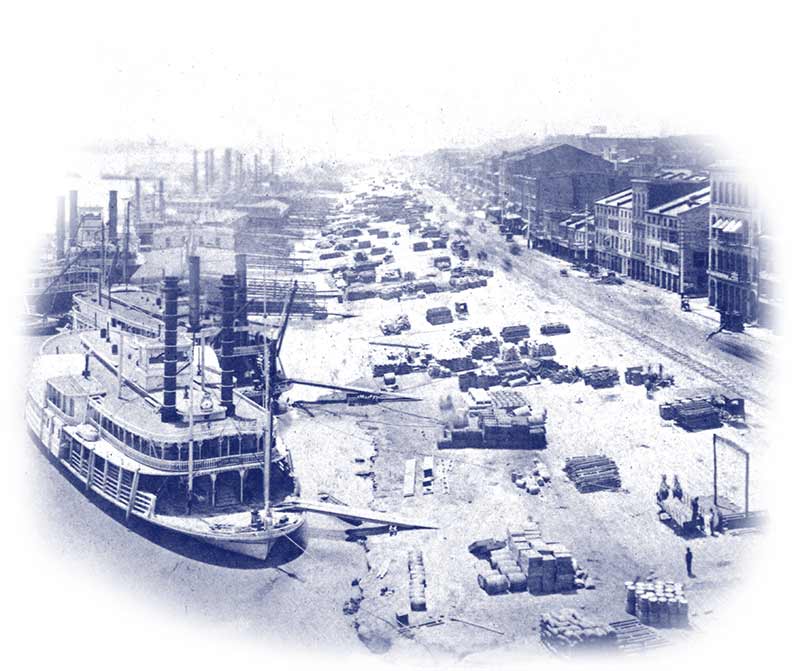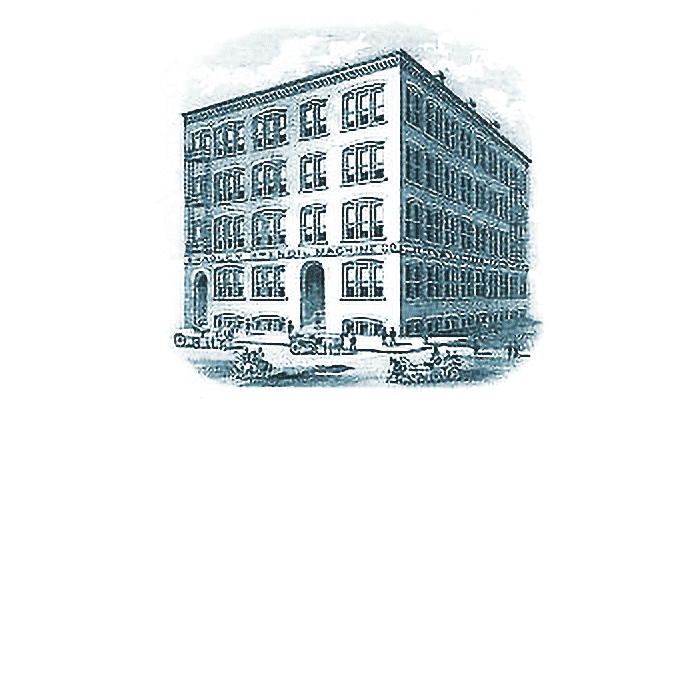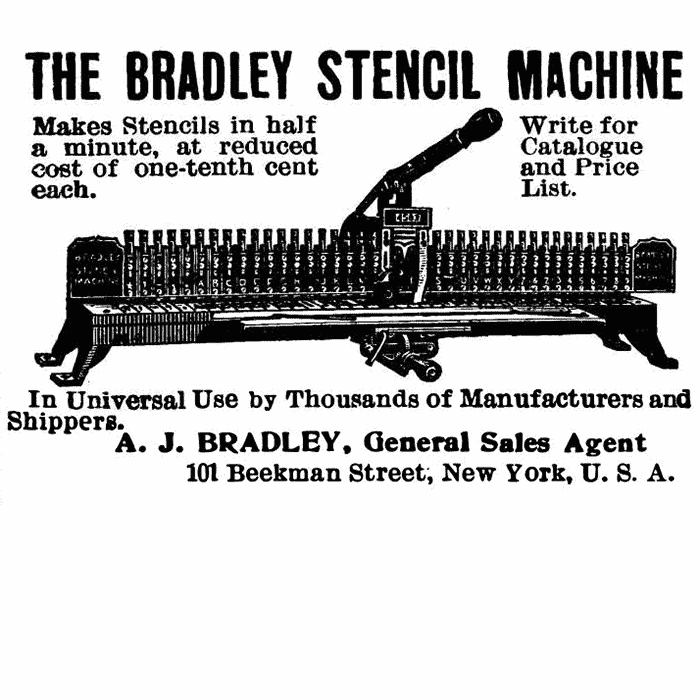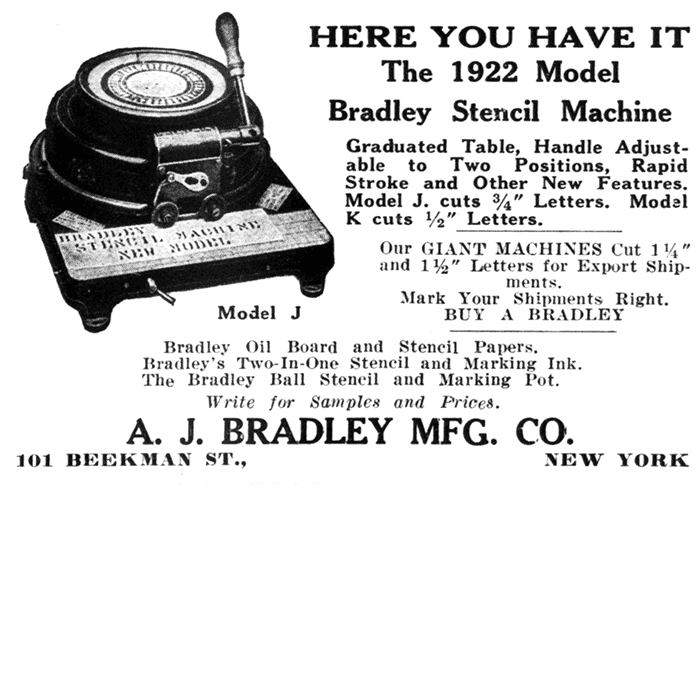Bradley Company History
History of Bradley Stencil Machine Company
Founding the Bradley Stencil Machine Co.
It is said: Andrew Jackson Bradley left his family’s Kansas farm at just eleven years old, determined to seek his fortune.
He eventually settled in St. Louis, Missouri, in the bustling Levee district.
Each day on his way to work, he walked along Washington Avenue, where cargo crates crowded the streets.
Many of these boxes sat idle for days, waiting to be marked before they could be shipped.
At the time, freight was labeled either by hand or with the use of letter stencils.
But stencils for specific uses, such as addresses, had to be cut individually, and even with ready-made stencil letter sets or tools, the letters could only be applied one by one.
Confronted with this inefficiency, Bradley began to imagine a faster, more practical solution.
Around 1892, Andrew Jackson Bradley invented the world first stencil cutting machine.
He fieled several patents for his invention.
In November 1893, Andrew J. Bradley and an investor group received incorporation for Bradley Stencil Machine Company.
It was the first company of its kind.
The capital stock was $40,000.
At that time, the purchasing power of 1 U.S. dollar was about the same as $35 in 2023.
So $40,000 in 1894 is about $1,400,000 in 2023.
However, it must also be said that only half of the amount actually needs to be deposited in order to establish the company.
And it was allowed to work with this capital after the incorporation.
The first factory building was in 2108-18 Papin Street, and the Office at 322 Pine Street, St. Louis.
The first president of the Bradley Co. was R. N. Hubbard, the first vice-president was John T. Milliken, the first secretary was C. S. Moffitt, and the general manager was W. A. Kinsey.
The company sold only seven units in its first year.
However, it is not entirely clear what year this refers to.
Seven machines for the month of December would be a good sales volume since the company was founded in November 1893.
Seven sales for all of 1894 would be a very slow start.
Keep in mind that this machine was completely new.
It had to find its way into the market.


The Worlds First Stencil Cutting Machine — the Long Bradley
The first stencil machines had a linear array of punches, as opposed to the circular array of punches used in today's manual stencil machines.
Bradley later referred to this as the »horizontal« model or long Bradley.
This model was available in both ½ inch and ¾ inch letter sizes and was manufacturted until about the 1930s.
The typeface is a slab serif with very little contrast.
It is slightly reminiscent of the traditional US Roman stencil typeface.
Later stencil machines were built in a circular shape, especially for larger letters like the machines for 1¼ and 1½ inch.
The first stencil machine with circular arranged punches was patented in 1898.
It must also be said that the circular stencil machines were somewhat cheaper to produce.
The 1924 book «The American Digest Of Business Machines» lists prices for Bradley stencil machines.
The horizontal model for ½ and ¾ inch stencil size cost $125 each.
The circular model for ½ and ¾ inch cost $110 each.
Andrew J. Bradley is also credited with the invention of the circular stencil machine.
However, Stephen D. Hartog, a former Bradley engineer, later patented many improvements.
In particular, he invented the interchangeable punches and dies.
His suggestions for improvements were not considered.
Hartog left the Bradley company to market his inventions on his own.
He didn't have much luck.
But in doing so, he set in motion a series of events that led to the founding of the second stencil machine company — Diagraph Stencil Machine Corporation - in 1902.
Diagraph Corp. would become Bradley's main competitor.
By 1900, the Bradley Stencil Machine Company consisted of the following managing directors - president John T. Milliken, vice-president R. N. Hubbard, first secretary C. S. Moffitt, and general manager G. S. Parker.
In 1901 Willis Perry Schureman became general mangar and in 1903 he was elected vice-president as well in position of general manager.
Andrew J. Bradley, the inventor left St. Louis and moved to New York being the general sales agent for Bradley company.
In December 1909, the »Iron Age« trade journal reported that the Bradley Stencil Company had purchased the vacant lot on the south side of Forest Park Boulevard in St. Louis to build a new manufacturing facility.
It cost $30,000 and was supposed to be made of steel and concrete.

first stencil machine, the horizontal model for ½ and ¾ inch stencil letters

¾ inch Roman typeface of the Bradley stencil machines

Circular stencil machine for 1¼ and 1½ inch letters, image 1910
A. J. Bradley Mfg. Co., New York
Andrew J. Bradleys second company
Andrew J. Bradley moved to New York City around 1900.
As a general sales agent for the Bradley Company, he did much to promote his invention, especially between 1900 and 1920.
But he was not a specialist in print advertising.
The only thing you will find in the newspapers is the same little ad over and over again.
Around 1912, he founded a second company, A. J. Bradley Mfg. Co., to manufacture and sell supplies for stencil cutting machines.
The supplies were oilboard, ink, and brushes.
He also did a lot of tinkering and research on other inventions.
The company was located at 101 Beekman Street, New York.
In 1949 the address is 45th Road, Jackson Ave. and its mentioned for the last time around 1950 at the address 43rd Ave. Long Island City, New York.
However, Andrew J. Bradley was not alive at that time.
He died in the early 1930s.
His heirs probably continued his business under his name for some time.
Acquisition by Diagraph Corporation — The End of Bradley Stencil Machine Company
Whenever the United States entered a war, or supported its allies, the volume of cargo increased dramatically and so did the need to mark the cargo quickly and effectively.
For all stencil machine manufacturers, this has meant huge increases in sales and profits.
The companies have had to expand their production capacity at a very fast pace.
However, sales of the machines fell below pre-war levels after the wars.
As the government no longer needed large quantities of stencil machines, the sale of old machines from government stocks actually led to a decline in sales of new machines.
The manufacturers downsize their production again.
This led to constant pressure on the companies.
Andrew J. Bradley died in the first half of the 1930s.
The Bradley Stencil Machine Company was thereafter majority-owned by his sister, Margaret.
In 1938 Diagraph Stencil Machine Corp. owner James W. Brigham saw an opportunity to acquire Bradley Stencil Machine Company.
The acquisition was completed on June 25, 1938.
The St. Louis Post-Dispatch annouced the takeover in the issue of June 26. 1938 with the following news.
DIAGRAPH CORPORATION ACQUIRES STENCIL MACHINE CO.
The Diagraph Stencil Machine Corporation has absorbed the Bradley Stencil Machine Co., established in 1893, it was announced yesterday.
The Diagraph Co. thus has acquired the factory property at 3745-51 Forest Park boulevard, together with the machinery, fixtures, equipment and goodwill of the Bradley Stencil Machine Co.
The plant is housed in a one-story brick and steel structure, with approxomately 15,000 feet of floor space.
The transfer includes an adjoining lot 50 by 185 feet.
T. Percy Carr represented the Bradley interests in the negotiations.
Both companies hold basic patents and important improvments.
James W. Brigham will head the new Diagraph-Bradley Stencil Machine Corporation, which will operate the Forest Park boulevard plant.
The present plant of Diagraph Co. is at 2915 Clark avenue.
...
With a second factory and Bradley's large existing customer base, the Diagraph Corp. would be in a better position to weather the economic downturn.
The acquisition was completed by the end of the year.
The result was the largest company in the stencil machine industry, with two factories.
The name of the new company was changed to Diagraph-Bradley Stencil Machine Corporation.
Even after that, Diagraph changed its name several times.
Today, the Diagraph brand is alive and well and is part of ITW.
Manual stencil machines are still manufactured by DiagraphMSP.
For more information about how the story continues, read the early history of Diagraph Corp.
at astype fonts.
Sources
- Google Patent Search
- Trade Journals: Office Appliances, Modern Packaging, Distribution & Warehousing, Traffic World, Iron Age ...
- St. Louis Post-Dispatch
- The book of St. Louisans; Leonard, John W., St. Louis, The St. Louis republic, 1906


